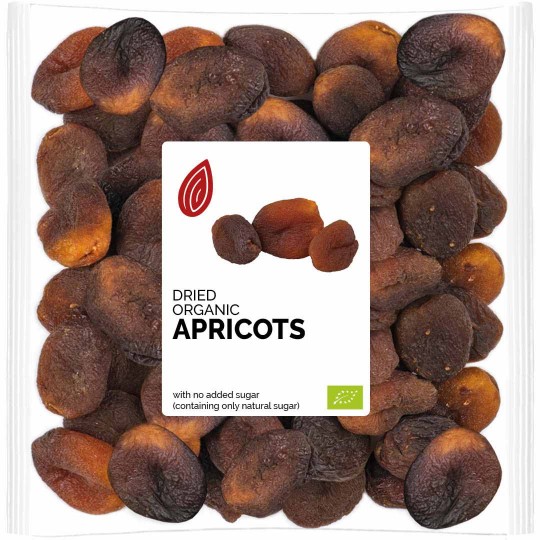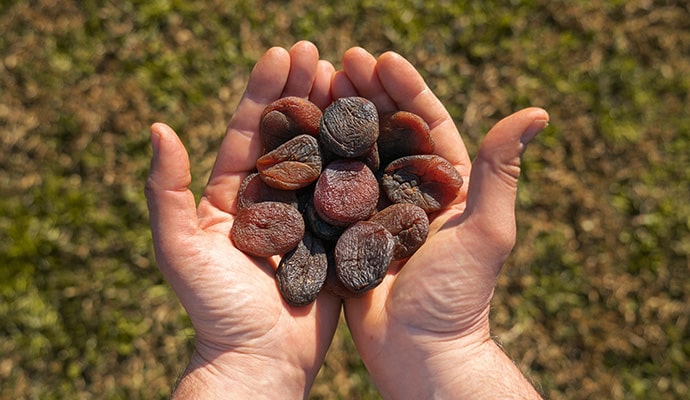


Buy online dried organic apricots with no added sugar (containing only natural sugar).
Our natural dried organic apricots are organic certified and are lovingly grown every day with care and respect for the environment and for those who work the land.
You can buy dehydrated organic apricots in packs that are ideal for true dried fruit lovers.
Discover the benefits of dried organic apricots! Our analyses showed that 100 g of dried organic apricots contain:
The characteristic dark colour is a result of the naturalness of the product and the absence of preservatives.
Ingredients: organic apricots. May contain traces of PEANUTS and NUTS.
Formats: 1 kg
Origin: Turkey

Ethical quality

Affordable price

Esclusively on Nuturally

Nutritional values
| Ingredients | Organic apricots. May contain traces of PEANUTS OR NUTS. |
| Weight | 1 kg |
| Storage requirements | Store in a cool, dry place |
| Organic | IT-BIO-009; Non-EU Agriculture; |
| Nutrition declaration | average nutritional values per 100 g: |
| Energy | 1234 kJ / 291 kcal |
| Fats | 0.5 g |
| of which saturates | 0 g |
| Carbohydrate | 65 g |
| of which sugars | 34 g |
| Fibre | 7.4 g |
| Protein | 3.0 g |
| Salt | 0.01 g |
| Copper | 0.37 mg (37% NRV*) |
| Potassium | 1352 mg (68% NRV*) |
| Source | Euro Company analysis |
| Recommendations | The advice provided SHOULD IN NO WAY BE CONSIDERED AS MEDICAL ADVICE OR PRESCRIPTION. The information provided shall be considered for informative and educational purposes only, it is not intended to replace medical advice. In case of a medical condition, always consult your doctor. |
| Origin | Turkey |
| Nutrients | Copper, Potassium |
| *NRV: Nutrient Reference Value | *Nutrient Reference Value |
| Label and packaging | The images are for illustrative purposes only, the product may be subject to changes depending on stock availability and selected weight. |
| Product | Apricot |
Curiosity
A legend says that originally the apricot was only an ornamental plant with beautiful white flowers. When Armenia was invaded by the enemies it was ordered to cut down all the trees that did not produce fruit to get timber, and this would have been the destiny of the apricot if a young girl had not cried under its foliage all night long. In the morning, golden fruit had grown on the tree: apricots. In other legends the apricot is also indicated as the forbidden fruit tasted by Adam and Eve instead of the apple. Another news comes from Arabic medical treatises: it seems that it was used to cure earache. In the English folk tradition, dreaming of the apricot brings good luck, while elsewhere it symbolizes shyness in love; according to another version, if you dream of dried apricots loss and damage are to be expected.
Apricots can be considered as a source of different phytocomposts such as polyphenols and carotenoids. The polyphenols, such as quercetin and catechin, have a high antioxidant and anti-inflammatory effect which helps reducing the risk of cardiovascular disease. Catechin, also responsible for the beneficial effects of green tea, acts by inhibiting the action of pro-inflammatory enzymes. There are also studies that demonstrate how a diet full of catechins can help protecting blood vessels and keep blood pressure under control. Carotenoids are lipid-type vegetable compounds distinguished by their yellow-red colour. They can have both a vitamin effect as precursors of vitamin A and antioxidant activity. Among the carotenoids, we have xanthophylls, compounds that have been the subject of several studies to demonstrate their protective effect on eyesight. Lutein, one of these, is mainly associated with an effect of protection of the retina, the membrane of the eyeball that acts as a light-converter, picking up the light stimuli and converting them into bioelectrical signals, which, in turn, are sent to the brain through the optic nerve fibres. Apricots are rich in fibre, which is essential for the health of the digestive system. A lot of this fibre is soluble and also helps regulating blood cholesterol levels. These fruits are also rich in potassium, a mineral that plays many roles in the body: for example, it plays a crucial role in the functioning of the nervous and muscular systems and helps keeping blood pressure normal.
Source:
Nutspaper 1/2016
History
The origin of the apricot is threefold as it comes from China, Central Asia and the Caucasus, all areas where the species has been widespread since 3000 BCE. Thanks to the merchant caravans, it spread slowly from those regions to the West, through central Asia, reaching Armenia and the Middle East. Its botanical binomial Prunus Armeniaca owes its name to Linnaeus' conviction that the plant was of Armenian origin. Armenia is still a fundamental diffusion point of this tree, as it was the place from where it was introduced to Greece and Europe, primarily due to the expeditions of Alexander the Great, and then of the Roman general Lucullus, who both acquainted the West with the different varieties of the plant, until then unknown. The Romans introduced it to Italy and Greece in 70-60 BCE, but its spread around the Mediterranean basin was later consolidated by the Arabs. Until the last century, however, apricots were not particularly widespread in Europe or in America, which was reached thanks to the English settlers. The tree also grows naturally in the Himalayas at altitudes of around 3,000 metres as a result of its stem's resistance to the cold climate.
As for the name, the Romans called it Armeniacum, which means Armenian apple, because it originated from there; or praecox, which in Latin means ‘early’ because it matured before peaches; from such root we also derive the Greek term 'praikokion'. 'Albicocca' in Italian – as well as the French ‘abricot’, the English ‘apricot’ and the Spanish ‘albaricoque’ – comes instead from the Arabic ‘albarquq’. In turn, the fruit gave its name to a shade of light orange, halfway between yellow and pink.
The apricot is a small tree, in the wild it can reach even 12-13 metres in height, while in the cultivations it is kept under 3.5 metres for care and harvesting reasons; it is a deciduous species that enters into vegetative rest during winter.
The plant has a variable appearing depending on the vegetative-productive habitus. The roots develop in depth, so much so that they need soils with a cultivation franc of at least 50-80 cm. The stem has a dark red-brown, longitudinally fissured rind. The average width of the trunk is 7-8 cm, but it varies from one cultivar to another. The buds, inserted on the knot, can be
woody and flowering: the first ones have a conical shape, while the second ones are roundish and, usually, localized on one-year-old branches; unlike the Pomaceae, in the apricot and in the other Drupaceae they are never mixed.
The one-year-old branches are reddish and lenticularly white; depending on the vigour and distribution of the flowering buds along their axis, they are divided into three categories:
-the mixed branch is on average vigorous and provided with flowering and wood buds (depending on the cultivar the flowering buds can be distributed along the whole branch, in the basal part or in the terminal part); there can also be ready buds on it that give rise to sprouts during the vegetative recovery itself (they are called anticipated branches), while the wood buds were formed in the year preceding the vegetative recovery;
-the brindillo is a slender branch with the approximate diameter of a pencil, about ten centimetres long and provided mainly with flowering buds, while the terminal one along the axis is woody;
-the floriferous dart, or May bunch, is a small branch a few centimetres long with a crown of flowering buds and the central one is woody.
The leaves are alternate, smooth, petiolate, heart-shaped, with more or less round glands, with serrated edge. At the beginning of their formation, they are reddish, then they become deep green and shiny.
The flowers are sessile (inserted on the branch without stalk), hermaphrodite, bell-like, solitary or coupled. They are single, but bloom in small groups located at the junction of the leaves. They vary from white to a delicate pinkish colour. They have five sepals and petals and many erect stamens. The apricot is generally a self-fertile plant, some recent North American and Canadian cultivars are partially self-sterile (the pollen of the same flower does not carry out fertilization), so they need pollinating varieties. The pollination is entomophilous, carried out by bees and other pollinating insects.
The fruit is an almost sessile drupe of round shape. The drupe is an indehiscent fleshy fruit with membranous epicarp, fleshy mesocarp and a lignifying endocarp (stone). In the specific case of the apricot, it is separated by a furrow with a variable depth called "suture line". It has a size between 3.5 and 6 cm. The skin, or epicarp, can be smooth or hairy, of yellow colour tinged with pink in the parts exposed to the sun. The pulp, or mesocarp, is pleasant, fragrant and melting, and the kernel, or endocarp, is woody and may or may not adhere to the mesocarp.
Source:
Nutspaper 1/2016
Properties
According to our analyses, 100 g of dried organic apricots contain:
Affordable price
Affordable price means to us offering our clients dried organic apricots with no added sugar (containing only natural sugar) that everybody can enjoy. We want, on the one hand, to place the proper value on raw materials in order to obtain a quality product by paying our farmers a fair price; on the other hand, we want to fulfil your needs when it comes to pricing. We establish fair long-term relationships with our producers to avoid race-to-the-bottom pricing and that are based on trust as part of our efforts to offer you the finest and most natural product.
Not only that: by choosing large packs of dried organic apricots, you are also contributing to the reduction in the use of plastic.
How much does 1 kg of dried organic apricots cost?
The price per kg for dried organic apricots depends on the apricots' quality, variety and origin. On Nuturally, we have selected the best dried organic apricots with respect for our supply chain, farmers, and raw materials.
Storage
You can store naturally-dried organic apricots away from sources of heat and moisture. Here are 4 useful tips:
Questions & Answers by Nut lovers
Be the first to ask a question about this product!